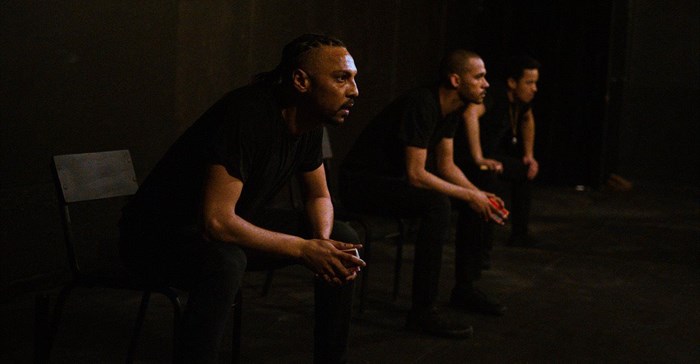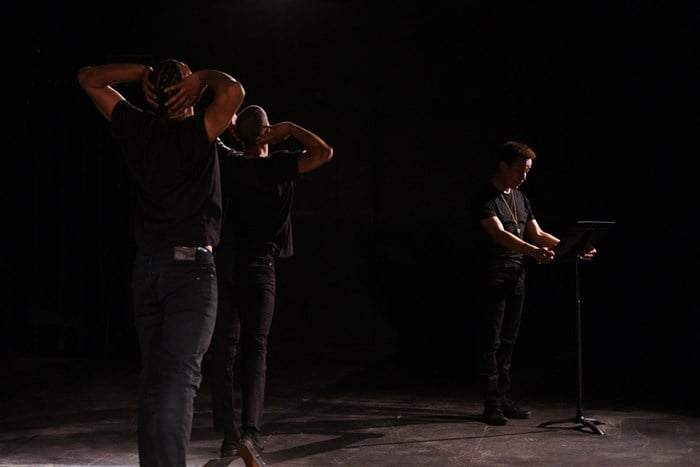Absolute silence. Absolute darkness. The effective delivery of the Karatara message relies on both. In return, the piece and its performers get absolute respect.

Image by Lindsey Appolis: Karatara deals with the tragedy of the Knysna fires
The Knysna fires of 2018 robbed residents of a small town of lives, livelihoods, houses – and hope. Two households were obliterated, claiming the lives of seven family members and an unborn child. Just over five years later, the loss and depth of grief among those directly affected remain all-consuming.
The actors in this dance drama, Dean Balie, Grant van Ster and Shaun Oelf, portray the chaos of the disaster through words and action – their panic, fear, and desperation underscored by carefully orchestrated sound design by director Gideon Lombard.
Oversized match boxes, rhythmic body slapping, stamping and voice provide percussive beats while recordings of news broadcasts emphasise their repeated mispronunciation of Ka-ra-ta-ra. In desperation, Van Ster and Oelf spell it out with movement. As one reviewer put it, dance becomes words; words become the dance.
Karatara is co-written by Oelf and Wilken Calitz and communicated mainly in Afrikaans. The script highlights the local communities’ complex racial and social history, and how “political powers and some media exploited this tragedy”. Oelf, in particular, reflects the anguish, despair, and emotional paralysis that often accompanies the loss of loved ones. Whether sudden or otherwise, the pain of one experience is no less than the other.

Image by Lindsey Appolis: Karatara deals with the tragedy of the Knysna fires
On the drive home, the impact of the performance takes hold and the sadness becomes overwhelming. I remember the words to the Bee Gees ballade, How Do You Mend a Broken Heart?; “For I can think of younger days when living for my life/ Was everything a man could want to do/ I could never see tomorrow, but I was never told about the sorrow/ … How can you mend this broken man?”
People process death differently, but those who have been there may face solitude, depression, isolation, and bottomless misery. But for how long? Balie communicates it so well. Do you work through it alone, or is there somebody out there who can help?
To try to heal, the challenge is to make peace with the event and perhaps search for heavenly guidance to find the strength to get through the day. A dancer might dance if they can find the energy. One has to dig deep to find the passion again. And then figure out how to express that grief through something that has previously brought so much joy.
Because when the endorphins inevitably return as the movement takes over and blocks the brain’s relentless thought processes, you can’t help but allow yourself a little smile as you remember how good it feels to do what you were born to do. A picture might paint a thousand words, but in Oelf’s case, movement is everything. He has only to twitch a muscle to have the same effect for an audience that is paying attention.
The final scenes of this 50-minute rollercoaster, lit mainly by torchlight, have Oelf in full view, writhing in a perfect circle of choreographed movement on the stage floor. He eventually stands, alone, still, and staring, his breath rasping as he clutches armfuls of props and recovers slowly from his exertions. Involuntarily, I take a deep breath in and exhale at the same time as he does. Blackout.
Oelf is a professional dancer and choreographer from Knysna who cofounded Figure of Eight Dance Collective with Van Ster in 2014. The two share a history in dance and theatre that has won them due accolades for their performance abilities. On stage together, they’re unbeatable. Add Balie to the mix, and you have the theatrical version of a tote trifecta. Balie is a drama graduate from the University of Stellenbosch.
His most recent achievement is a 2012 Fleur du Cap theatre award for Best Actor in a Musical for his role as Kat Diamond in David Kramer and Taliep Petersen’s Kat and the Kings.
Director Lombard graduated as a theatre maker from UCT and was recently nominated for a Safta in the Best Actor category for Stam (The Tree). He, too, has won multiple awards and even more nominations for the one-man show, Die Reuk van Appels.
And Calitz, who has master’s degrees in music and creative writing, received Fleur du Cap nominations for the play 2092: God van Klank (2015 – Best New South African Text) and Kristalvlakte (2016 – Best Original Soundtrack).
Their combined effort produced by Marie Vogts for Karatara ensured victory for the Best Debut Production at this year’s KKNK. It was also nominated for Best Theatre Production, Best Director, and Best Theatre Design. It’s a moving story that will not be forgotten.
Karatara is on at The Baxter daily until 24 September. Tickets are R180 and R100 for pensioners here.



























![Today, Halo and Demographica announce a new specialist agency, Second Rodeo]], headed up by Mike Stopforth (left). Dean Oelschig, managing partner and founder of Halo (right) says they will work as a group but ultimately, each agency will be an individual specialist](https://biz-file.com/c/2505/772543-64x64.jpg?2)








